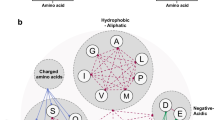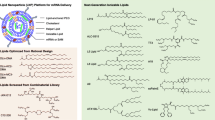Abstract
Genetic instability of tumor cells can result in translation of proteins that are out of frame, resulting in expression of neopeptides. These neopeptides are not self-proteins and therefore should be immunogenic. By eluting peptides from human glioblastoma multiforme (GBM) tumor cell surfaces and subjecting them to tandem mass spectrometry, we identified a novel peptide (KLWGLTPKVTPS) corresponding to a frameshift in the 3′ beta-hydroxysteroid dehydrogenase type 7 (HSD3B7) gene. HLA-binding algorithms predicted that a 9-amino acid sequence embedded in this peptide would bind to HLA-A*0201. We confirmed this prediction using an HLA-A*0201 refolding assay followed by live cell relative affinity assays, but also showed that the 12-mer binds to HLA-A*0201. Based on the 9-mer sequence, optimized peptide ligands (OPL) were designed and tested for their affinities to HLA-A*0201 and their abilities to elicit anti-peptide and CTL capable of killing GBM in vitro. Wild-type peptides as well as OPL induced anti-peptide CTL as measured by IFN-γ ELISPOTS. These CTL also killed GBM tumor cells in chromium-51 release assays. This study reports a new CTL target in GBM and further substantiates the concept that rational design and testing of multiple peptides for the same T-cell epitope elicits a broader response among different individuals than single peptide immunization.





Similar content being viewed by others
References
Hou LC, Veeravagu A, Hsu AR, Tse VC (2006) Recurrent glioblastoma multiforme: a review of natural history and management options. Neurosurg Focus 20:E5
Laws ER, Parney IF, Huang W et al (2003) Survival following surgery and prognostic factors for recently diagnosed malignant glioma: data from the Glioma Outcomes Project. J Neurosurg 99:467–473
Novellino L, Castelli C, Parmiani G (2005) A listing of human tumor antigens recognized by T cells: March 2004 update. Cancer Immunol Immunother 54:187–207
Antwi K, Hanavan PD, Myers CE, Ruiz YW, Thompson EJ, Lake DF (2009) Proteomic identification of an MHC-binding peptidome from pancreas and breast cancer cell lines. Mol Immunol 46:2931–2937
Stryhn A, Pedersen LO, Holm A, Buus S (2000) Longer peptide can be accommodated in the MHC class I binding site by a protrusion mechanism. Eur J Immunol 30:3089–3099
Gebreselassie D, Spiegel H, Vukmanovic S (2006) Sampling of major histocompatibility complex class I-associated peptidome suggests relatively looser global association of HLA-B*5101 with peptides. Hum Immunol 67:894–906
Falk K, Rotzschke O, Stevanovic S, Jung G, Rammensee HG (1991) Allele-specific motifs revealed by sequencing of self-peptides eluted from MHC molecules. Nature 351:290–296
Stevanovic S, Schild H (1999) Quantitative aspects of T cell activation–peptide generation and editing by MHC class I molecules. Semin Immunol 11:375–384
Hunt DF, Henderson RA, Shabanowitz J et al (1992) Characterization of peptides bound to the class I MHC molecule HLA-A2.1 by mass spectrometry. Science 255:1261–1263
Kast WM, Brandt RM, Sidney J et al (1994) Role of HLA-A motifs in identification of potential CTL epitopes in human papillomavirus type 16 E6 and E7 proteins. J Immunol 152:3904–3912
Parker KC, Bednarek MA, Hull LK et al (1992) Sequence motifs important for peptide binding to the human MHC class I molecule, HLA-A2. J Immunol 149:3580–3587
Pogue RR, Eron J, Frelinger JA, Matsui M (1995) Amino-terminal alteration of the HLA-A*0201-restricted human immunodeficiency virus pol peptide increases complex stability and in vitro immunogenicity. Proc Natl Acad Sci USA 92:8166–8170
Ruppert J, Sidney J, Celis E, Kubo RT, Grey HM, Sette A (1993) Prominent role of secondary anchor residues in peptide binding to HLA-A2.1 molecules. Cell 74:929–937
Smith MH, Nuara AA, Egen JG, Sirjani DB, Lam KS, Grimes WJ (1998) Baculoviral expressed HLA class I heavy chains used to screen a synthetic peptide library for allele-specific peptide binding motifs. Mol Immunol 35:1033–1043
Linnebacher M, Gebert J, Rudy W et al (2001) Frameshift peptide-derived T-cell epitopes: a source of novel tumor-specific antigens. Int J Cancer 93:6–11
Saeterdal I, Bjorheim J, Lislerud K et al (2001) Frameshift-mutation-derived peptides as tumor-specific antigens in inherited and spontaneous colorectal cancer. Proc Natl Acad Sci USA 98:13255–13260
Schwitalle Y, Linnebacher M, Ripberger E, Gebert J, von Knebel Doeberitz M (2004) Immunogenic peptides generated by frameshift mutations in DNA mismatch repair-deficient cancer cells. Cancer Immun 4:14
Townsend A, Ohlen C, Rogers M, Edwards J, Mukherjee S, Bastin J (1994) Source of unique tumour antigens. Nature 371:662
Elliott T, Bodmer H, Townsend A (1996) Recognition of out-of-frame major histocompatibility complex class I-restricted epitopes in vivo. Eur J Immunol 26:1175–1179
Cheng JB, Jacquemin E, Gerhardt M et al (2003) Molecular genetics of 3beta-hydroxy-Delta5–C27-steroid oxidoreductase deficiency in 16 patients with loss of bile acid synthesis and liver disease. J Clin Endocrinol Metab 88:1833–1841
van der Burg SH, Ras E, Drijfhout JW et al (1995) An HLA class I peptide-binding assay based on competition for binding to class I molecules on intact human B cells. Identification of conserved HIV-1 polymerase peptides binding to HLA-A*0301. Hum Immunol 44:189–198
Korbie DJ, Mattick JS (2008) Touchdown PCR for increased specificity and sensitivity in PCR amplification. Nat Protocols 3:1452–1456
Smith MH, Lam KS, Hersh EM, Lebl M, Grimes WJ (1994) Peptide sequences binding to MHC class I proteins. Mol Immunol 31:1431–1437
Lam KS, Lebl M, Krchnak V (1997) The “One-Bead-One-Compound” combinatorial library method. Chem Rev 97:411–448
Lam KS, Salmon SE, Hersh EM, Hruby VJ, Kazmierski WM, Knapp RJ (1991) A new type of synthetic peptide library for identifying ligand-binding activity. Nature 354:82–84
Dionne SO, Myers CE, Smith MH, Lake DF (2004) Her-2/neu altered peptide ligand-induced CTL responses: implications for peptides with increased HLA affinity and T-cell-receptor interaction. Cancer Immunol Immunother 53:307–314
Parkhurst MR, Salgaller ML, Southwood S et al (1996) Improved induction of melanoma-reactive CTL with peptides from the melanoma antigen gp100 modified at HLA-A*0201-binding residues. J Immunol 157:2539–2548
Kumar N, Mohanty D (2007) MODPROPEP: a program for knowledge-based modeling of protein-peptide complexes. Nucleic Acids Res 35:W549–W555
Rammensee H, Bachmann J, Emmerich NP, Bachor OA, Stevanovic S (1999) SYFPEITHI: database for MHC ligands and peptide motifs. Immunogenetics 50:213–219
Myers CE, Dionne SO, Shakalya K, Mahadevan D, Smith MH, Lake DF (2008) Variation in cytotoxic T-lymphocyte responses to peptides derived from tyrosinase-related protein-2. Hum Immunol 69:24–31
Dionne SO, Smith MH, Marincola FM, Lake DF (2003) Functional characterization of CTL against gp100 altered peptide ligands. Cancer Immunol Immunother 52:199–206
Dionne SO, Smith MH, Marincola FM, Lake DF (2001) Antigen presentation of a modified tumor-derived peptide by tumor infiltrating lymphocytes. Cell Immunol 214:139–144
Ishikawa T, Fujita T, Suzuki Y et al (2003) Tumor-specific immunological recognition of frameshift-mutated peptides in colon cancer with microsatellite instability. Cancer Res 63:5564–5572
Belicha-Villanueva A, Blickwedehl J, McEvoy S, Golding M, Gollnick SO, Bangia N (2010) What is the role of alternate splicing in antigen presentation by major histocompatibility complex class I molecules? Immunol Res 46:32–44
Ward AJ, Cooper TA (2010) The pathobiology of splicing. J Pathol 220:152–163
Kalnina Z, Zayakin P, Silina K, Line A (2005) Alterations of pre-mRNA splicing in cancer. Genes Chromosomes Cancer 42:342–357
Gan HK, Kaye AH, Luwor RB (2009) The EGFRvIII variant in glioblastoma multiforme. J Clin Neurosci 16:748–754
Farabaugh PJ (1996) Programmed translational frameshifting. Annu Rev Genet 30:507–528
Fernandez J, Yaman I, Huang C et al (2005) Ribosome stalling regulates IRES-mediated translation in eukaryotes, a parallel to prokaryotic attenuation. Mol Cell 17:405–416
Hansen TM, Reihani SN, Oddershede LB, Sorensen MA (2007) Correlation between mechanical strength of messenger RNA pseudoknots and ribosomal frameshifting. Proc Natl Acad Sci USA 104:5830–5835
Bodmer S, Strommer K, Frei K et al (1989) Immunosuppression and transforming growth factor-beta in glioblastoma. Preferential production of transforming growth factor-beta 2. J Immunol 143:3222–3229
Finke J, Ferrone S, Frey A, Mufson A, Ochoa A (1999) Where have all the T cells gone? Mechanisms of immune evasion by tumors. Immunol Today 20:158–160
van Besouw NM, Zuijderwijk JM, de Kuiper P, Ijzermans JN, Weimar W, van der Mast BJ (2005) The granzyme B and interferon-gamma enzyme-linked immunospot assay as alternatives for cytotoxic T-lymphocyte precursor frequency after renal transplantation. Transplantation 79:1062–1066
Acknowledgments
We would like to thank HoJoon Lee, M.S. for the frameshift database.
Author information
Authors and Affiliations
Corresponding author
Rights and permissions
About this article
Cite this article
Myers, C.E., Hanavan, P., Antwi, K. et al. CTL recognition of a novel HLA-A*0201-binding peptide derived from glioblastoma multiforme tumor cells. Cancer Immunol Immunother 60, 1319–1332 (2011). https://doi.org/10.1007/s00262-011-1032-4
Received:
Accepted:
Published:
Issue Date:
DOI: https://doi.org/10.1007/s00262-011-1032-4




